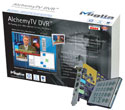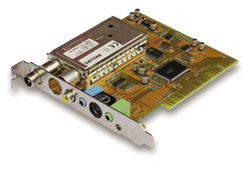
Miglia AlchemyTV/ DVR
Company: Miglia
Price: $149.99
www.miglia.com
About six months ago or so, I finally had the opportunity to put my television to the full use I originally wanted it for: HDTV. When my local cable company (everybody’s favorite, Comcast) finally rolled out HDTV and DVR service to my area, I was one of the first to jump on that bandwagon. And while the HDTV picture quality did not disappoint, it was not what impressed me the most. I became a DVR junkie.
DVR, or Digital Video Recorder, allows you to record TV, pause live TV, and so much more. It has been great; affording me the opportunity to schedule recordings and watch the shows I want to see when I want to watch them. How is that different from a VCR, you may ask? It’s like the difference between a World War II fighter plane and a F-22. They both do similar things, but…
I’ve had DVR functionality before, notably in the PowerMac G4 I still use as a file server. I had run both an earlier version of Miglia AlchemyTV and EyeTV when they first came out, and was none too impressed with either solution at the time. Both offered clunky software, crappy video, and limited export control. Other than that, they both worked. I had actually planned to do a head-to-head comparison of them a few years ago, but was so disillusioned by both products I never got around to it.
So here comes a new version of the AlchemyTV/DVR system, promising a fix to all the gripes I had with the older version.
Set Up
The AlchemyTV/DVR is a PCI card that plugs into the back of your PowerMac G4 or G5 (I’m testing it with a G5). Because this is a PCI card, you will be required to open up your Mac, free up a PCI port (chances are you have at least two still open and free) and install the unit. If this sounds like a daunting task, trust me that it’s not. (Besides, you should have some compressed air in a can and blowing the dust out of your Mac from time to time anyway, right?)

Installation was simple, and the Alchemy PCI card came with clear instructions. Once installed in your Mac, you can plug in your coaxial cable from your cable or satellite provider via the coaxial plug, as well as connecting another video source via the S-Video or composite cable plug. In this case, I plugged in a VCR I usually only use when converting older videotapes to digital, but more on that in a moment.
Software was a simple install as well, although the software on the CD-ROM that came with the AlchemyTV/DVR was out of date and not compatible with my current OS, 10.4. I don’t consider this a negative, however, as many programs suffer this fate as quickly as Apple updates the system software on Macintosh computers. I simply checked the Alchemy website before installing the AlchemyTV/DVR software to make sure I was using the most recent version. I do this with all software that comes on CD-ROM, and recommend others to do the same. If you have to install software from a CD-ROM, you may want to check the company website before launching the program to check for any updates.
The AlchemyTV/DVR software is simple to use, and features a plug-in architecture so that the software has the ability to do much more with third-party plug-ins. For this review, however, I did not use any third party additions.
The software can be automatically setup by answering a few basic questions, entering your zip code, and the like. This is done so that when you are changing channels, the actual station call letters will be displayed rather than a simple channel number. This also helps to find video files later after you have recorded them.
Users are able to adjust picture quality via the built-in Image Settings control panel. Here you can adjust Hue, Saturation, Contrast, Brightness, and Sharpness. If you get carried away, there is a “Factory Settings†button to return the settings to the default. I found that the default settings were a bit off, and my picture quality benefited with a little more Sharpness. Your mileage may vary.
One neat feature is the ability to control not only the size of the picture window, but its transparency and whether it’s always in front of other windows or not. This is great if, say, you want to catch the news while you are checking your email or browsing the Internet, want to see the picture, but still be able to read text underneath the TV window as well. This feature works very well, and for some, is well worth the price of admission alone.
Scheduling a recording in AlchemyTV/DVR is simple. Select the time, date, and other options and you’re all set. You can set up a one-time recording, a weekly recording, or even a daily recording schedule. Unlike a TiVo, however, you cannot set up an AlchemyTV/DVR to record all episodes that you enjoy of a particular show automatically. You have to set the schedule yourself, manually. While this makes an AlchemyTV/DVR a little less user friendly, there are many other options that you don’t get with a set-top DVR. Read on. The program also used iCal to make sure you don’t miss a recording.
The picture quality is very good, or at least as good as your input. If you connect via rabbit ears, don’t expect high-quality video. Basic cable will look good, as will other input devises, which brings me to what makes me really enjoy the AlchemyTV/DVR.
A niece asked me if I could convert a VHS copy to a DVD for her church group. No problem, I figured, I’ve done it a lot of times. Usually, I connect a VCR to my digital camcorder, and then connect the camcorder to my Mac. Launch iMovie, set the camcorder to bridge, and play the VCR. Complicated for some people, true, but I had done it a bunch of times. Then it dawned on me, I could connect the VCR directly to the AlchemyTV/DVR card, and use the AlchemyTV/DVR software to record the video. This cuts out a bunch of cables, steps, and time. Because the AlchemyTV/DVR software records in a variety of video codec’s, including MPEG 4, DV in both NTSC and Pal, DVCPRO at 720p60 and 1080i60 (Those are high def), Component Video, h.263, h264, Sorenson Video and Video 3, and a host of other. You can also control the quality of the compression for each codec, all in the name of getting the best quality (which I wanted for this project) or saving space if you only plan on watching a recorded show once and toss it in the trash afterwards.
So how did the AlchemyTV/DVR do for this project? Flawlessly. The quality was spot-on, and the video file was quickly dropped into iDVD for quick conversion to DVD.
All in all, I’m very pleased with the AlchemyTV unit. It works well with TitanTV, so finding programs worth recording is a snap. It takes any guesswork out of getting quality video into your Mac, and full screen viewing looks fantastic. It also makes it simple to convert older videos to digital files, which you can then burn to DVD, make compilations, post on the Internet, or email to a friend.
Requirements:
PowerMac G4 or G5
Free PCI or PCI-X slot
PowerPC G4/400 processor and higher
256 MB of RAM
Mac OS X 10.3 and higher
Technical Data:
Max viewing size: 752*576 (PAL), 640*480 (NTSC)
Two years limited warranty
TV/Antenna, Composite IN, S-Video IN, stereo Audio IN
Pros
Easy installation. Simple user interface. Good codec support. Integration with iCal. Remote Control. Open plug-in architecture. Features composite and S-Video in. Multiple size windows, from small to full screen.
Cons
Software requires a 16-digit serial number. Why? No other PCI card can use the software. This is an unnecessary encumbrance on customers. In fact, when I received my review unit, the software did not work at all. Turns out that the serial number my AlchemyTV/DVR came with was actually for the AlchemyTV software only, which is much more limited than the DVR model.
Conclusion
A nice piece of software and hardware. I would recommend it to anyone looking to bring video into their Mac, watch television, and who wants to set-up recordings. TiVo like functionality would make this an even better product.

Leave a Reply
You must be logged in to post a comment.